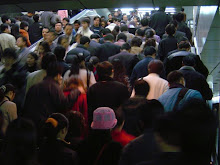Dear friends and family,
I am officially on my summer holidays!
My plans are to travel through the south-west province of Yunnan and then fly to Kathmandu to visit some family while exploring the ever-beautiful Nepal.
I'll be doing a lot of traveling within Yunnan as it has been described by some as having some of the most "magical and diverse scenery in all of China; there are endless trekking opportunities in the south's tropical rainforests, and in the north, snow-capped Tibetan peaks hide dozens of tiny villages and temples rarely visited by tourists."
Yúnnán is also home to a third of all China's ethnic minorities (nearly 50% of the province is non-Han) and despite the best government efforts, numerous pockets of the province have successfully resisted Han influence and exhibit strong local identities, which means I'll definitely have a good taste of what else China has to offer other than skyscrapers and neon lights!
Here are the cities I'll be visiting in Yunnan:
Jinghong: My first stop will be to soak up the Southeast Asian atmosphere in the capital of tropical Xīshuāngbănnà. I was originally planning on reserving a lovely tree-house type hotel room in the middle of an elephant reserve but they were closed this season due to renovations so I'll have to content myself with a trek instead. (I'll be spending approx 3 days here)
Yuányáng: I've heard of this magical place through coworkers and can't wait to watch the sun rise and set on the magnificent Yuányáng rice terraces. It's the middle of the season so the terraces will be a lovely shade of green but in the fall when the terraces are filled with water the sun rises and sets while leaving a rainbow of colours that stretch for acres on the waters in the paddies. Do a Google image search for "Yuányáng rice terraces". You won't be disappointed. (I'll be spending approx 2 days here)
Kūnmíng: Kunming is the capital of Yunnan and has become a thoroughly modern Chinese city with wide, palm-lined roads and sky-scraping modern buildings. There are a few interesting markets and temples there that should keep me busy for a few days. (Will probably stay here 3 days)
Dàlǐ: Dali is known as a backpacker's paradise but the title is quickly being placed on Lijiang instead. Where Dàlǐ does come out ahead, however, is with its stunning location sandwiched between mountains and Erhai Lake (Ěrhǎi Hú). There's fascinating possibilities for exploring and getting to know the region's Bai culture. I'm hoping to get my hands on a rented bike and get out of town where all the beauty still lies. (I'll be spending approx 4 days here)
Lìjiāng: Lìjiāng will be my final destination before flying out to Nepal. The maze of cobbled streets, rickety old wooden buildings and gushing canals makes it one of the most visited sites in northern Yúnnán. But, apparently its popularity has grown faster than its ability to absorb the microphone-toting tour groups.
There is a debate amongst travelers between Lijiang and Dali as to which is more authentic. I find that it's a shame that people have to debate whether a city in China is deemed authentic enough. But to be honest I have seen how tourism has turned cities into mega money machines and it is becoming harder and harder to see what is still real anymore. In any case I'm in China and I can't deny that it's all still authentic to me. (I'll be spending about 4 days here)
As for Nepal, I'll be visiting Jason's lovely family for 3 weeks who have generously accepted to take me in and show me an insider's guide to Nepal. Nepal has been said to be a real shopping heaven and I've already made a little shopping list of things I need to bring back home – Silver, Paintings, Fabrics, Prints. Along with shopping I'm hoping to get around to seeing the historic downtown Thamel area and Old Town.
Nepal is a mystery to me; I have come to learn much from Jason and his family but until I actually step foot in Kathmandu's busy streets I don't think I could ever come close to understanding.
"Draped along the greatest heights of the Himalaya, Nepal is where the ice-cold of the mountains meets the steamy heat of the Indian plains. It's a land of yaks and yetis, stupas and Sherpas and some of the best trekking on earth. The Himalaya's most sophisticated urban cultures took shape here, in the three great minikingdoms of the Kathmandu Valley - Kathmandu, Patan and Bhaktapur - home to a world-class artistic and architectural heritage."
Here's more information on Nepal: http://www.lonelyplanet.com/nepal/kathmandu
Well, I will leave you with this for now. I'll try and keep you all updated but I'm at the mercy of old computers and wonky internet connections in hostels.
Much love and Happy Summer!









-754699.jpg)















